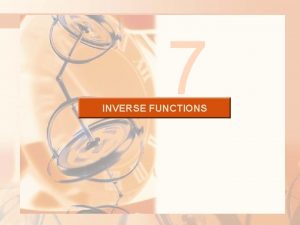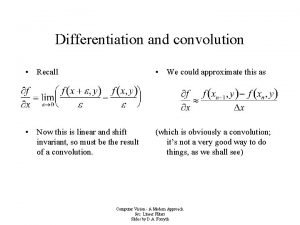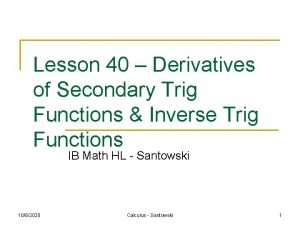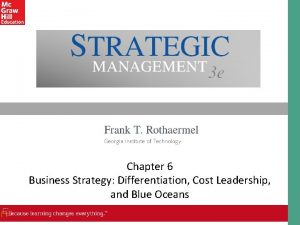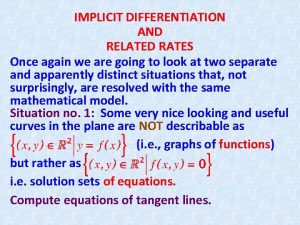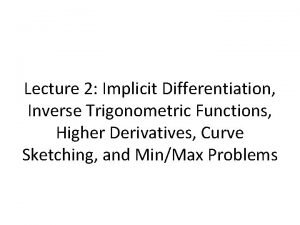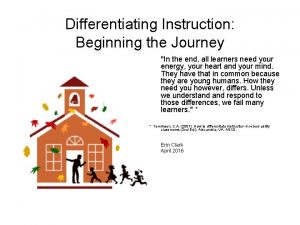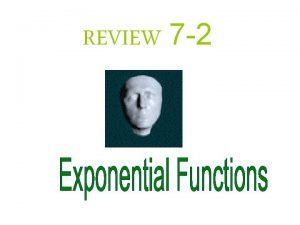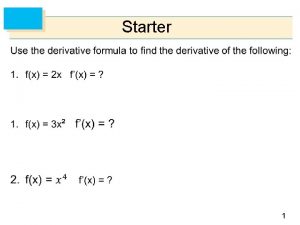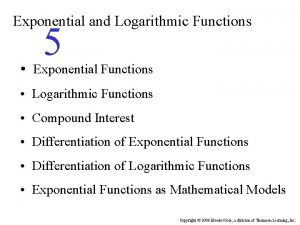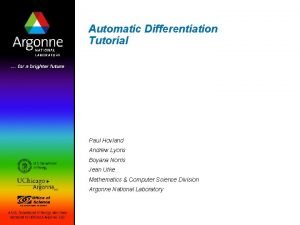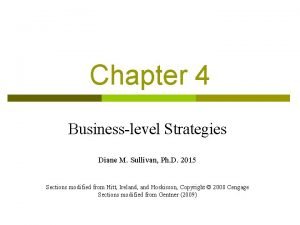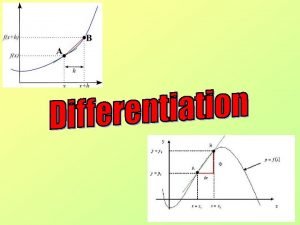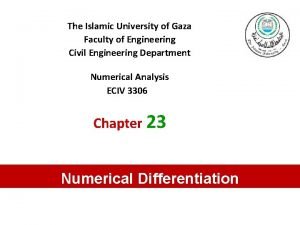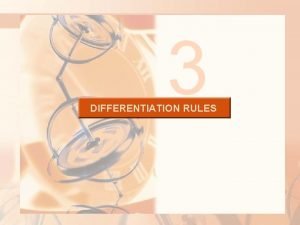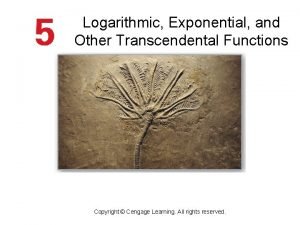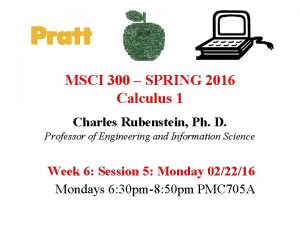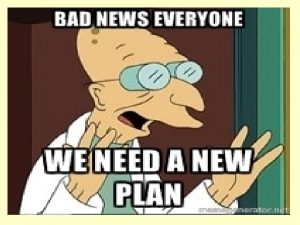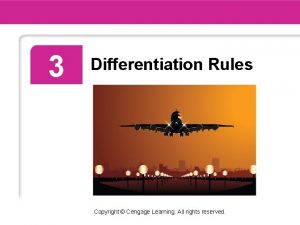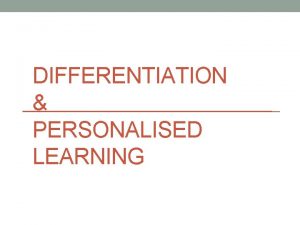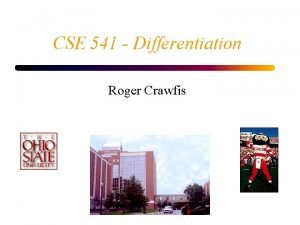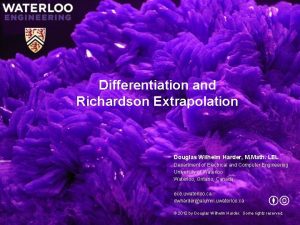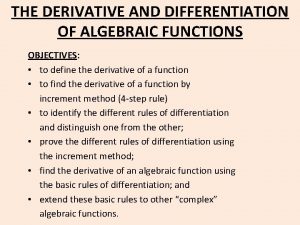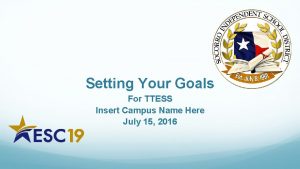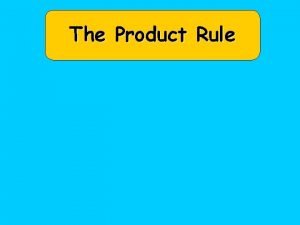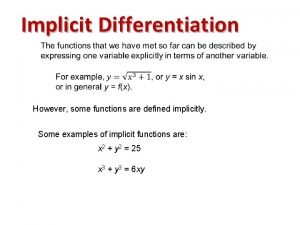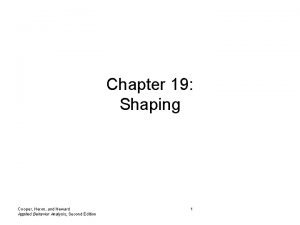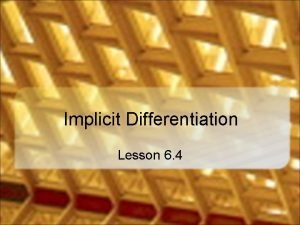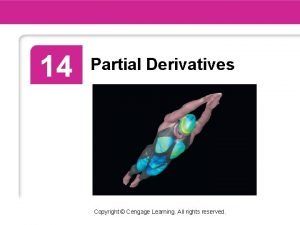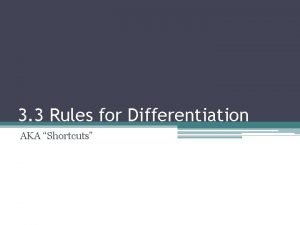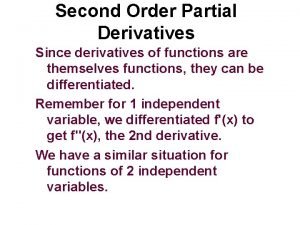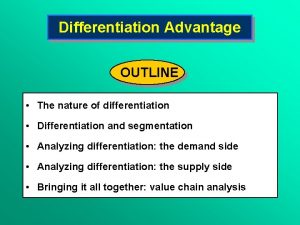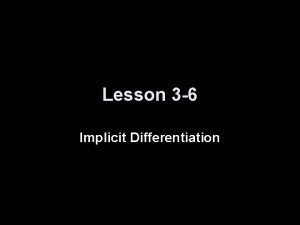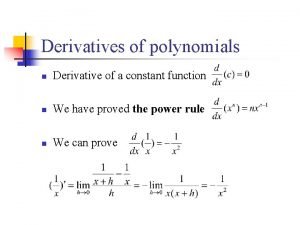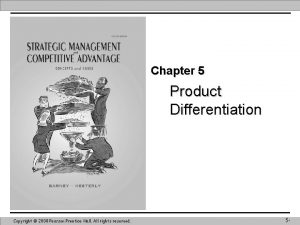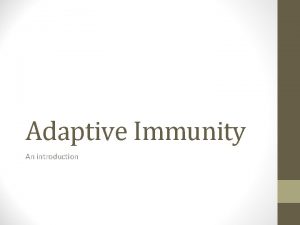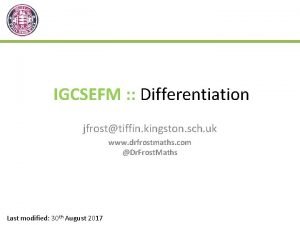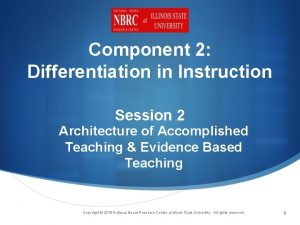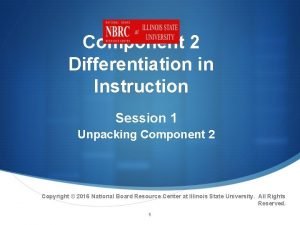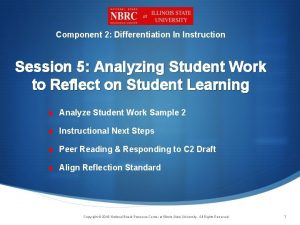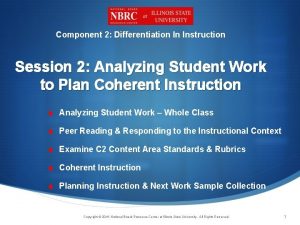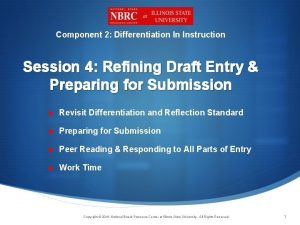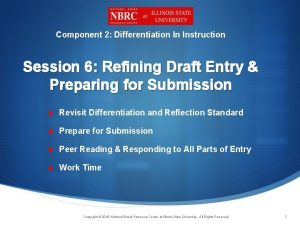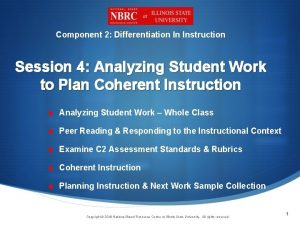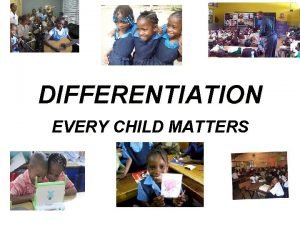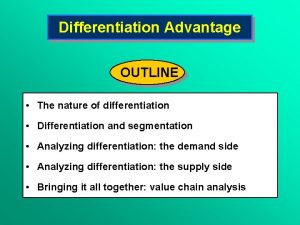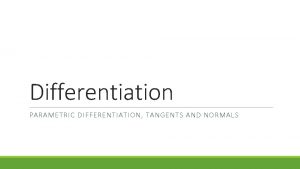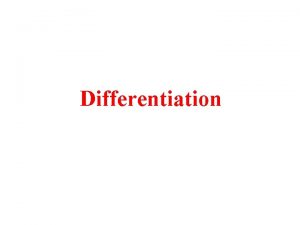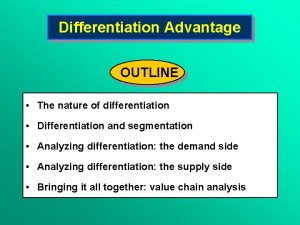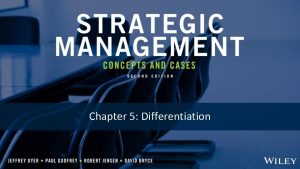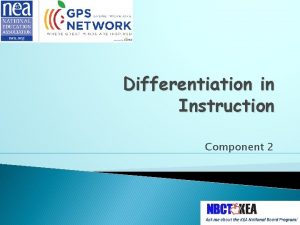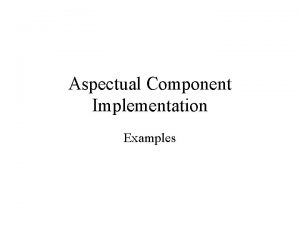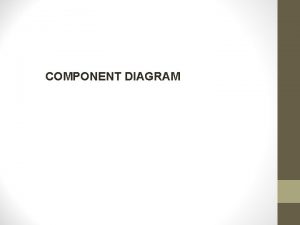Component 2 Differentiation In Instruction Session 3 S


















































- Slides: 50

Component 2 Differentiation In Instruction Session 3 S Writing About Teaching S Reviewing the Architecture of Accomplished Teaching S Preparing to write the Instructional Context S NBPTS Content Standards S Setting Appropriate Learning Goals Copyright © 2018 National Board Resource Center at Illinois State University. All Rights Reserved. 1

Welcome § Be sure to sign in § Please log on to your National Board Profile to monitor your current status § What have you learned about your students since our last cohort session? Copyright © 2018 National Board Resource Center at Illinois State University. All Rights Reserved. 2

Overview of Session 3 Topics § Writing About Teaching: Three Types of Writing § Reviewing the Architecture of Accomplished Teaching § Preparing to write the Instructional Context part of the written commentary of the entry § Examining National Board Content Area Standards & Rubrics § Writing Appropriate Goals based upon Student Information Copyright © 2018 National Board Resource Center at Illinois State University. All Rights Reserved. 3

Topic 1: Writing About Teaching Purpose: ü Identify types of writing reflected in the Portfolio entry questions ü Clarify that consistent evidence is provided when the description, analysis, and reflection of teaching practice is aligned & linked to one another Copyright © 2018 National Board Resource Center at Illinois State University. All Rights Reserved. 4

Homework for Session 3 § Clarification: Read and highlight pages 16 -30 – Writing About Teaching in the General Portfolio Instructions (2018) Copyright © 2018 National Board Resource Center at Illinois State University. All Rights Reserved. 5

Three Types of Writing Key Information § All certificate portfolio instructions are grounded in the Architecture of Accomplished Teaching Framework and will require candidates to describe, analyze, and reflect on their practice. § Since assessors will only have what is provided to them in the entry materials (video recordings, instructional materials, and written commentary), candidates must demonstrate that they appropriately described, analyzed, and reflected upon their practice and have used this analysis appropriately to guide future teaching. § Your analysis of your featured teaching is a crucial element conveyed solely by your written commentary. In other words, you may have strong evidence, but your analysis of that evidence is what “unpacks” your thinking and makes it convincing for the assessors. § Consistent evidence is provided when the description, analysis, and reflection of your practice is aligned and linked to one another. Copyright © 2018 National Board Resource Center at Illinois State University. All Rights Reserved. 6

Three Types of Thinking/Writing § Descriptive – what happened? § Analytical – why or how did it happen? § Reflective – how would you handle this same situation in the future? Copyright © 2018 National Board Resource Center at Illinois State University. All Rights Reserved. 7

Descriptive Writing § Contains accurate and precise enumeration and/or explanation of critical features § Provides clear and logical ordering of the elements or features of the event, person, concept, or strategy described § Includes all features or elements that an outsider would need to be able to visualize your classroom (sets the stage) § Specifies the meaning of any abbreviation or acronym the first time it is used Copyright © 2018 National Board Resource Center at Illinois State University. All Rights Reserved. 8

Analytical Writing § Deals with reasons, motives, and interpretation of why elements or events described as the way they are – provides rationale § Shows assessors the thought processes that you used to arrive at your conclusions about a given teaching situation § Demonstrates the significance of the evidence you submit § Provides convincing reasoning, based on evidence, for interpretations and rationales. Copyright © 2018 National Board Resource Center at Illinois State University. All Rights Reserved. 9

Reflective Writing § Analysis and reflection can overlap § Reflection is a thought process you engage in after a teaching experience § Allows you to make decisions about how you would approach similar situations in the future § Shows assessors how you use what you have learned from your teaching experiences to inform and improve your practice in the future Copyright © 2018 National Board Resource Center at Illinois State University. All Rights Reserved. 10

Consistent Evidence When all your writing is aligned & supports your practice, then you are providing consistent evidence, required in the Level 4 rubric Copyright © 2018 National Board Resource Center at Illinois State University. All Rights Reserved. 11

Portfolio Entry Instructions: Component 2 School Counseling Portfolio Entry Instructions Description Analysis Copyright © 2016 National Board Resource Center at Illinois State University. All Rights Reserved. 12

Portfolio Entry Instructions: Component 4 Early Adolescence Through Young Adulthood/Career and Technical Education Description Analysis Or Both? Copyright © 2018 National Board Resource Center at Illinois State University. All Rights Reserved. 13

Application: Find your Component Certificate Portfolio Entry Instructions - Written Commentary Section Locate your Written Commentary Questions. Code them as: Description Analysis Reflection Written Commentary Questions are found here Copyright © 2018 National Board Resource Center at Illinois State University. All Rights Reserved. 14

The Architecture of Accomplished Teaching Is A Framework for Writing About Teaching § First, focus on the students, answering key questions based upon what you know about your students. § Next, focus on reading & understanding the standards, instructions and rubrics. § Set worthwhile learning goals that are reasonable and justifiable for these students at this point in time. Copyright © 2018 National Board Resource Center at Illinois State University. All Rights Reserved. 15

Application: Architecture of Accomplished Teaching When will you use each type of writing? Description Analysis Reflection Copyright © 2018 National Board Resource Center at Illinois State University. All Rights Reserved. 16

Architecture of Accomplished Teaching, Instructions, Standards & Rubrics § National Board Standards contain information about what accomplished teachers know & are able to do in a specific content area § Standards, Instructions & Level 4 rubric all align to help you articulate your teaching as an accomplished teacher Copyright © 2018 National Board Resource Center at Illinois State University. All Rights Reserved. 17

Extended Practice: Examples of the Three Types of Writing § Turn to page 20 in the General Portfolio Directions § Chose one example to read, noting the fonts that indicate the different types of writing contained in the example § Share thoughts you may have about the Three Types of Writing § Which type of writing seems the most natural? § Which type of writing seems the most difficult? Copyright © 2018 National Board Resource Center at Illinois State University. All Rights Reserved. 18

Extended Practice: Three Types of Writing Quiz § Take the “Three Types of Writing Quiz” on your own or with a partner. § Discuss & justify your responses § The three types of writing, although they appear to be separate, can overlap depending on the context of the question. § You will use the different types of writing in conjunction with each other to fully answer the questions in the written commentary Copyright © 2018 National Board Resource Center at Illinois State University. All Rights Reserved. 19

Topic 2: Preparing to Write the Instructional Context Purpose: Prepare to write the first draft of the Written Commentary ü Examine the questions & determine what kind of writing is required ü Determine what information should be included in this portion of the written commentary Copyright © 2018 National Board Resource Center at Illinois State University. All Rights Reserved. 20

Portfolio Instructions EA Science: Written Commentary Knowledge of students Goal Setting Implementing Instructional strategies Assessment Copyright © 2018 National Board Resource Center at Illinois State University. All Rights Reserved. 21

Examine your Instructional Context Section in your Component 2 Instructions What Kind of writing is required? 22 Copyright © 2018 National Board Resource Center at Illinois State University. All Rights Reserved.

What Do I Need To Do? Examine your Instructional Context Section in your Component 2 Instructions ü Begin a word document with the questions from this entry ü What kind of writing is requested? ü Do you have the necessary information? ü How will you organize the information? Copyright © 2018 National Board Resource Center at Illinois State University. All Rights Reserved. 23

Topic 3: Reviewing NBPTS Content Standards & Level 4 Rubric Purpose: ü Reinforce the concept of alignment between information given about the students & content area knowledge ü Become familiar with how the Instructions, Standards and Level 4 Rubrics are aligned Copyright © 2018 National Board Resource Center at Illinois State University. All Rights Reserved. 24

Standards describe what accomplishe d teaching looks like in your certificate area. Science Standards Third Edition for teachers of students ages 11– 18+ Assessors are trained to judge your performance solely on the basis of the criteria established in the Standards. Copyright © 2018 National Board Resource Center at Illinois State University. All Rights Reserved. 25

Portfolio Instructions EA Science: Written Commentary Knowledge of students Goal Setting Implementing Instructional strategies Assessment Copyright © 2018 National Board Resource Center at Illinois State University. All Rights Reserved. 26

Knowledge of Students Goal Setting Implementing Instructional strategies Assessment Copyright © 2018 National Board Resource Center at Illinois State University. All Rights Reserved. 27

Assessors evaluate & score your responses through the lens of the rubrics, which are derived from the Standards. Knowledge of students Goal Setting Implementing Instructional strategies Assessment Copyright © 2018 National Board Resource Center at Illinois State University. All Rights Reserved. 28

Extended Practice Copyright © 2018 National Board Resource Center at Illinois State University. All Rights Reserved. 29

Extended Practice Copyright © 2018 National Board Resource Center at Illinois State University. All Rights Reserved. 30

Copyright © 2018 National Board Resource Center at Illinois State University. All Rights Reserved. 31

Extended Practice Example from EA Health Copyright © 2018 National Board Resource Center at Illinois State University. All Rights Reserved. 32

Topic 4: Setting Appropriate Learning Goals Purpose: Practice writing clear, concise goals ü Clarify the need for clear goal writing as an ESSENTIAL understanding/skill for all candidates ü Determine the difference between a learning goal & an activity goal ü Provide information on: composing learning goals, types of learning targets Copyright © 2018 National Board Resource Center at Illinois State University. All Rights Reserved. 33

Align Targets, Goals, Assessments & Instruction Gain a clear vision of the target “Unpack” the Standards Write learning goals that tell what students should be able to do as a result of this lesson or lesson series Write goals that describe the level of rigor students demonstrate Determine how students will show what they know & can do Determine how to help students reach the target Develop the Assessme nt Plan the instructio n Alignment Copyright © 2018 National Board Resource Center at Illinois State University. All Rights Reserved. 34

Evidence Based Teaching: A Way of Structuring Classroom Planning & Instruction Teachers continuously collect, interpret & use evidence of student learning Leading to appropriate decisions to guide further instruction Goal of Evidence Based Teaching Is to Design Learning Experiences: That set high, worthwhile meaningful learning goals that meet individual needs That align with state/district learning standards & NBPTS standards for accomplished teaching That empower all students to effectively demonstrate what they have learned 35 Copyright © 2018 National Board Resource Center at Illinois State University. All Rights Reserved.

Quick Primer on Goal Writing A B C D Approach Smart Goals S Audience – the learner S Behaviors – what will they learn? S Conditions – when or what situations S Degree – criterion for success 36 Copyright © 2018 National Board Resource Center at Illinois State University. All Rights Reserved.

The Audience: Who Are My Students? The entry asks you to show evidence of differentiating instruction & assessment strategies for students in relation to a specific content area. Ask: • Who are they? • Where are they now? • What do they need & • When do they need it? • Where should I begin? Copyright © 2018 National Board Resource Center at Illinois State University. All Rights Reserved. 37

A B C D Method § The Behavior(s) § What do you want the students to learn? § What type of behavior do you expect? Copyright © 2018 National Board Resource Center at Illinois State University. All Rights Reserved. 38

Conditions § Usually a WHEN S “when given a set of five unlabeled slides” S “when given a list of common over the counter drugs” S “while working independently” or WHILE statement § Under what Conditions will they demonstrate this goal? Copyright © 2018 National Board Resource Center at Illinois State University. All Rights Reserved. 39

How Will You Measure It? Degree or Criteria for Success § What has to happen for the learner to succeed? § The standard or criteria for judging the behavioral performance. Speed Accuracy Quality Quantity Copyright © 2018 National Board Resource Center at Illinois State University. All Rights Reserved. 40

Defining a Goal S Usually National Board uses the term “goal” for multiple types of goals: S Overall goals S Unit goals or lesson goals S You may have used the terms differently based on specificity of moving from goals to objectives. S Learning goals are the specific learning targets that mesh the objectives of the prescribed course curriculum with students’ readiness and needs S Appropriate learning goals allow the teacher to help each student progress from a current position along a learning continuum to the desired destination, in appropriate, yet challenging increments 41 Copyright © 2018 National Board Resource Center at Illinois State University. All Rights Reserved

Learning Goals or Activities? Learning Goals: Students will: Learning Activities: Students will: § Distinguish between words beginning with “p” & “b” § Play bingo using words beginning with “p” & “b” § Identify the capital of each state § § Determine the electrical conductivity of different materials Play Jeopardy to practice identifying capitals of each state § Conduct an experiment investigating the electrical conductivity of different materials Copyright © 2018 National Board Resource Center at Illinois State University. All Rights Reserved. 42

§ Recognize a poem in sonnet form. § Distinguish between different types of triangles. § Read the next chapter and answer the questions. § Identify three major types of water pollution and the causes of each. Play the game of basketball. § Regroup addition problems involving 3 digit numbers. § Determine the quantities of ingredients needed if a recipe is tripled. § Do a science experiment with magnets & batteries. § Explain the factors leading to the Industrial Revolution. § Take a walking field trip to look for signs of autumn. § Identify the characteristics of living things. § Role play a conversation between General Washington & his troops at Valley Forge. (adapted from Take One activity book, 2005) Ø Next to each statement, indicate whether it is an activity (A) or a learning goal (G) § Learning Goal or Activity? Copyright © 2018 National Board Resource Center at Illinois State University. All Rights Reserved. 43

When Writing Learning Goals… Make sure learning goals: § § § Align with state/district/local content standards & curriculum requirements. Advance high expectations & worthwhile learning. Specify clearly what student will learn, rather than what activities they will complete. § Are appropriate for all your students. § Can be achieved with accomplished teaching strategies. § § Questions Candidates Can Ask One Another: Show your goals align with state/local content standards…. . § Describe how these goals advance high expectations & worthwhile learning § Tell how you justify these goals § What will students learn as a result of this lesson or lesson series? § What do you know about your students that makes this an appropriate goal at this time? § How will this goal meet the needs of the ability range in your class? § How will you measure these goals? Can be measured using classroom -based assessment methods. Copyright © 2018 National Board Resource Center at Illinois State University. All Rights Reserved. 44

To Summarize, First, Focus on the Students Where are my students intellectually, socially & emotionally? What can my students do at this time in relation to the content addressed by this component? Clarify the student background knowledge that helps them to be prepared for this content. 45 Copyright © 2018 National Board Resource Center at Illinois State University. All Rights Reserved.

Next, consider how the standards are unpacked to connect with student skills & abilities in this content area How do my students learn best in relation to the content for this component? What is the ability range of the class in relation to the content addressed in this component? What are my students’ interests that impact my planning for the content addressed in this component? What is a realistic, measurable learning goal for my students at this point in time? Copyright © 2018 National Board Resource Center at Illinois State University. All Rights Reserved. 46

re § Three Types of Writing: How does each type of writing help me articulate my teaching practice with evidence? § Knowledge of Students Standard: How does what I know about my students influence my practice? How can I learn more about my students? § Examining NB Content Area Standards, Rubrics & Instructions describe what accomplished teaching looks like in my certificate area: What am I already doing that demonstrates accomplished teaching? § Instructional Context: How can I succinctly explain my Instructional Context for the featured unit of study? § Setting Appropriate Goals based upon Student Information: How can I use my standards and student assessment information to write clear, concise goals? Copyright © 2018 National Board Resource Center at Illinois State University. All Rights Reserved. 47

Preparing for the Next Cohort Session § Write the Instructional Context portion of your Written Commentary § Be sure to begin or continue collecting student work and assessment information § Bring a class work sample for Session 4 § Bring updated goals, lesson plans, and assessment data for the unit of study you may feature in your entry § Read and highlight the Assessment standards for your certificate area § Locate, read & highlight the level 4 rubric in your certificate specific instructions Copyright © 2018 National Board Resource Center at Illinois State University. All Rights Reserved. 48

• Cohort members reflect on the session together • Any cohort member can take notes for the group • Teacher Liaison uses this form to share what’s happening in the cohort with the administrator Copyright © 2018 National Board Resource Center at Illinois State University. All Rights Reserved. 49

Be Sure to Reflect on: • Students • Teaching Strategies Copyright © 2016 National Board Resource Center at Illinois State University. All Rights Reserved. 50
 Individualized instruction vs differentiated instruction
Individualized instruction vs differentiated instruction Direct instruction method
Direct instruction method Give geometric interpretation of partial derivatives
Give geometric interpretation of partial derivatives Hyperbolic differentiation formulas
Hyperbolic differentiation formulas Ixj
Ixj Derivative of convolution
Derivative of convolution Tan inverse x differentiation
Tan inverse x differentiation Product differentiation
Product differentiation Cost leadership and differentiation
Cost leadership and differentiation Nestle differentiation strategy
Nestle differentiation strategy Specialization vs differentiation
Specialization vs differentiation Implicit differentiation and related rates
Implicit differentiation and related rates Implicit differentiation with inverse trig functions
Implicit differentiation with inverse trig functions Science differentiation in action
Science differentiation in action Scaffolding vs differentiation
Scaffolding vs differentiation Differentiation of 1/x
Differentiation of 1/x Formula of differentiation
Formula of differentiation Exponential formula
Exponential formula Automatic differentiation tutorial
Automatic differentiation tutorial Integrated cost leadership/differentiation strategy
Integrated cost leadership/differentiation strategy Differentiate in
Differentiate in High accuracy differentiation formulas
High accuracy differentiation formulas Sinh inverse x formula
Sinh inverse x formula Segmentation targeting differentiation and positioning
Segmentation targeting differentiation and positioning A differentiation strategy works best when a
A differentiation strategy works best when a Transcendental functions
Transcendental functions Reciprocal rule calculus
Reciprocal rule calculus Niche differentiation capsim
Niche differentiation capsim Differentiation of cosh2y
Differentiation of cosh2y Derivatives of arc trig functions
Derivatives of arc trig functions Differentiation
Differentiation Numerical differentiation
Numerical differentiation Ncca differentiation
Ncca differentiation Total derivative
Total derivative Richardson extrapolation formula
Richardson extrapolation formula Differentiation
Differentiation Ttess goal samples
Ttess goal samples Differentiation product rule
Differentiation product rule X^4+y^4=16 implicit differentiation
X^4+y^4=16 implicit differentiation Shaping aba cooper
Shaping aba cooper Implicit differentiation
Implicit differentiation Intermediate variable
Intermediate variable Constant multiple theorem
Constant multiple theorem Partial differentiation
Partial differentiation What is differentiation advantage
What is differentiation advantage Rules of implicit differentiation
Rules of implicit differentiation Derivative of a constant
Derivative of a constant Product rule differentiation
Product rule differentiation 5 bases of differentiation
5 bases of differentiation Differentiation of t cell
Differentiation of t cell Dr frost maths differentiation
Dr frost maths differentiation



